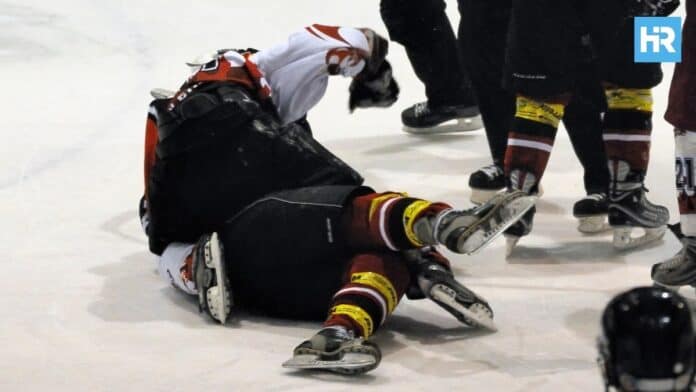Hockey’s high-speed, hard-hitting action makes it one of the most thrilling sports to watch.
But behind the excitement lies a history of dangerous, often devastating injuries. In this article, we spotlight the most shocking injuries in hockey history, revealing the physical toll on players and how evolving safety measures aim to protect the game’s future.
- Players like Clint Malarchuk and Richard Zednik have survived harrowing, life-threatening neck injuries, underscoring the dangers inherent in the sport.
- These significant incidents have driven changes in hockey safety measures, including the widespread use of neck guards for goalies.
- The recoveries of players such as Bryan Berard and Erik Karlsson highlight both the progress in sports medicine and the unwavering spirit of professional athletes.
Most Devastating Injuries in Hockey History
Celebrated for its relentless speed and bone-crushing physicality, hockey has also witnessed some of the most horrifying injuries that reshaped the sport and altered players’ lives forever.
From life-threatening neck wounds to brutal, career-ending collisions, these incidents tested human limits and sparked crucial changes in safety standards across the league.
In this in-depth report, we explore the most shocking injuries in hockey history—along with the powerful stories of survival, comeback, and lasting reform they triggered.
Clint Malarchuk: Neck Injury That Changed Hockey
On March 22, 1989, Clint Malarchuk, the Buffalo Sabres’ goalie, suffered one of the most horrifying injuries ever seen in professional sports. A skate blade from an opposing player accidentally sliced his carotid artery, leading to a life-threatening situation on the ice. The quick actions of the team’s athletic trainer, who manually pinched the artery closed, are credited with saving Malarchuk’s life. This incident brought about a mandate for goalies to wear neckguards, forever changing safety standards in the history of hockey.
Richard Zednik: Near-Fatal Injury
Similar to Malarchuk’s accident, Richard Zednik of the Florida Panthers experienced a severe neck laceration during a game on February 10, 2008. A teammate’s skate blade accidentally cut his external carotid artery, leading to immediate and profuse bleeding. Zednik’s swift skate to the bench and subsequent medical attention saved his life, highlighting the dangers players face every time they step onto the ice.
Steve Moore: The Career-Ending Injury
On March 8, 2004, Steve Moore of the Colorado Avalanche was attacked from behind by Todd Bertuzzi of the Vancouver Canucks, resulting in a pile-up that left Moore with three fractured vertebrae in his neck and a concussion. This assault ended Moore’s professional hockey career and led to legal action, raising serious questions about violence and retribution in the sport.
Bryan Berard: Eye Injury That Nearly Ended a Career
Bryan Berard, a promising defenseman for the Toronto Maple Leafs, suffered a catastrophic eye injury on March 11, 2000. An opponent’s stick accidentally struck him in the eye, severely damaging his vision and almost ending his career. Despite the grim prognosis, Berard underwent several surgeries and returned to play in the NHL, showcasing an incredible determination and love for the game.
Ted Green: Skull Fracture That Shocked Everyone
In a preseason game in 1969, Ted Green of the Boston Bruins engaged in a stick-swinging duel with Wayne Maki of the St. Louis Blues. The altercation resulted in Green sustaining a major skull fracture, which sidelined him for an entire season. This incident is a stark reminder of the dangers of unchecked aggression on the ice.
Erik Karlsson: Overcoming an Achilles Tendon Slice
Erik Karlsson, a defenseman for the Ottawa Senators, had his Achilles tendon sliced by a skate blade during a game in 2013. The injury required surgery and extensive rehabilitation, but Karlsson made a remarkable return to the ice, continuing to perform at an elite level.
The Most Gruesome Injuries in Hockey and Their Lasting Consequences
These unforgettable incidents expose the intense physical punishment endured by the sport’s most resilient athletes.
The determination of players who suffer devastating injuries and fight to return highlights hockey’s raw toughness and deep-rooted camaraderie.
Their stories reveal the high-stakes reality of professional sports while spotlighting advances in sports medicine and the evolution of safety standards sparked by these traumatic events.






